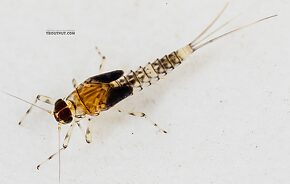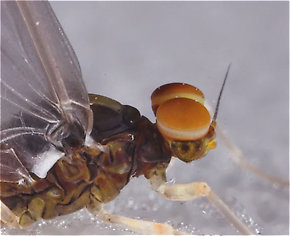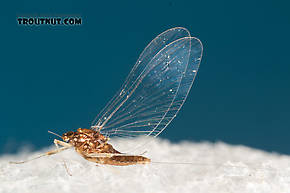Blog & Latest Updates
Fly Fishing Articles
Insects by Common Name


Little Slate-Winged Brown Quills
Scientific Names
Like most common names, "Little Slate-Winged Brown Quill" can refer to more than one taxon. They're previewed below, along with 2 specimens. For more detail click through to the scientific names.
Mayfly Species Baetis intercalaris
These are sometimes called Little Slate-Winged Brown Quills.
Mayfly Species Baetis brunneicolor
These are very rarely called Little Slate-Winged Brown Quills.
This is the largest common species of Baetis on our trout streams, and it can hatch in incredible numbers, drawing impressive rises of selective trout.
Anglers may have read in books about Baetis hiemalis, which is now a synonym (Synonym: A former name of a taxon, usually a species. Entomologists frequently discover that two insects originally described as different species are one in the same, and they drop one of the names. The dropped name is said to be a synonym of the remaining name. These changes take a while to trickle into the common knowledge of anglers; for example, Baetis vagans is now a synonym of Baetis tricaudatus.) of Baetis brunneicolor. It appears to have been a name for the fall-hatching brood of this species, which was reported to prefer slow water and weedy habitat instead of the gravelly riffles of the early summer brood.
Anglers may have read in books about Baetis hiemalis, which is now a synonym (Synonym: A former name of a taxon, usually a species. Entomologists frequently discover that two insects originally described as different species are one in the same, and they drop one of the names. The dropped name is said to be a synonym of the remaining name. These changes take a while to trickle into the common knowledge of anglers; for example, Baetis vagans is now a synonym of Baetis tricaudatus.) of Baetis brunneicolor. It appears to have been a name for the fall-hatching brood of this species, which was reported to prefer slow water and weedy habitat instead of the gravelly riffles of the early summer brood.
Mayfly Species Plauditus dubius
These are very rarely called Little Slate-Winged Brown Quills.
This species may produce good hatches.
Mayfly Species Baetis flavistriga
These are very rarely called Little Slate-Winged Brown Quills.
This is one of the most widespread and abundant Baetis species, and it may produce fishable hatches under a variety of conditions.
This species is known in angling books by several old synonyms (Synonym: A former name of a taxon, usually a species. Entomologists frequently discover that two insects originally described as different species are one in the same, and they drop one of the names. The dropped name is said to be a synonym of the remaining name. These changes take a while to trickle into the common knowledge of anglers; for example, Baetis vagans is now a synonym of Baetis tricaudatus.), including Baetis quebecensus, Baetis levitans, Baetis cingulatus, and Baetis phoebus, in addition to the correct name.
This species is known in angling books by several old synonyms (Synonym: A former name of a taxon, usually a species. Entomologists frequently discover that two insects originally described as different species are one in the same, and they drop one of the names. The dropped name is said to be a synonym of the remaining name. These changes take a while to trickle into the common knowledge of anglers; for example, Baetis vagans is now a synonym of Baetis tricaudatus.), including Baetis quebecensus, Baetis levitans, Baetis cingulatus, and Baetis phoebus, in addition to the correct name.
Male Baetis flavistriga (BWO) Mayfly Nymph View 8 PicturesThis nymph keys to Baetis assuming the villipore is present (hard to see in my photos or scope), and within that genus it tentatively keys to the flavistriga species complex, of which Baetis flavistriga itself is by far the most common in Washington state, so that's the most likely ID.
View 8 PicturesThis nymph keys to Baetis assuming the villipore is present (hard to see in my photos or scope), and within that genus it tentatively keys to the flavistriga species complex, of which Baetis flavistriga itself is by far the most common in Washington state, so that's the most likely ID.
 View 8 PicturesThis nymph keys to Baetis assuming the villipore is present (hard to see in my photos or scope), and within that genus it tentatively keys to the flavistriga species complex, of which Baetis flavistriga itself is by far the most common in Washington state, so that's the most likely ID.
View 8 PicturesThis nymph keys to Baetis assuming the villipore is present (hard to see in my photos or scope), and within that genus it tentatively keys to the flavistriga species complex, of which Baetis flavistriga itself is by far the most common in Washington state, so that's the most likely ID.See 2 more specimens...
Mayfly Species Acentrella turbida
These are very rarely called Little Slate-Winged Brown Quills.
These tiny mayflies were once known by the names Pseudocloeon carolina in the East and Pseudocloeon turbidum in the West. They are now considered synonymous. With the new species name turbida, these mayflies were also moved to the genus Acentrella. The combining of these two species has made turbida's distribution trans-continental. In places their numbers compensate for their small size and make for excellent hatches.
In the West, turbida is more variable in size and appearance than its eastern iteration, in keeping with the large and varied regions it inhabits. It can run as small as 3.5 mm and as large as 5 mm, the larger sizes tending to be more brownish. It is often confused with the smaller broods of Diphetor hageni, but its conical mesonotal projection (Conical mesonotal projection: small cone shaped spike sticking up from the top and front part of the middle thorax segment.), lack of hind-wings, exaggerated turbinate ( Turbinate: Shaped like a top or elevated on a stalk; usually refers to the eyes of some adult male Baetidae mayflies which are wider near the tip than at the base.) eyes (hence its name) and stockier build help to differentiate it.
Turbinate: Shaped like a top or elevated on a stalk; usually refers to the eyes of some adult male Baetidae mayflies which are wider near the tip than at the base.) eyes (hence its name) and stockier build help to differentiate it.
They are often found on the water with a mix of other Baetidae mayflies, making for very challenging fishing.
In the West, turbida is more variable in size and appearance than its eastern iteration, in keeping with the large and varied regions it inhabits. It can run as small as 3.5 mm and as large as 5 mm, the larger sizes tending to be more brownish. It is often confused with the smaller broods of Diphetor hageni, but its conical mesonotal projection (Conical mesonotal projection: small cone shaped spike sticking up from the top and front part of the middle thorax segment.), lack of hind-wings, exaggerated turbinate (

This male Baetidae dun has slightly turbinate eyes.
They are often found on the water with a mix of other Baetidae mayflies, making for very challenging fishing.
See 3 more specimens...
Top 10 Fly Hatches
Top Gift Shop Designs
Eat mayflies.
Top Insect Specimens
Miscellaneous Sites
Troutnut.com is copyright © 2004-2024 Jason
Neuswanger (email Jason). See my FAQ for information about use of my images.
 privacy policy
privacy policy

